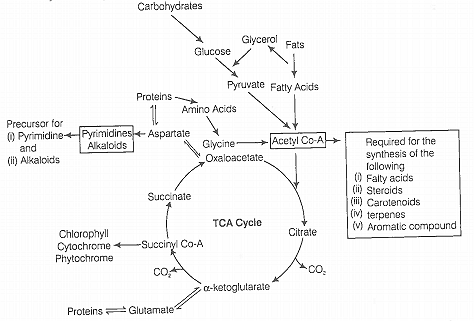Living cells obtain energy through respiration. It is the process of generating energy in the form of ATP molecules by breaking down food molecules like glucose, fats, etc.
The process starts with glycolysis which occurs in cytoplasm producing pyruvic acid. It is then converted to acetyl Co-A, which enters mitochondrial matrix. This initiates the tricarboxylic acid cycle.
This cycle is said to be amphibolic because many intermediate compounds formed in this cycle act as precursors for biosynthesis of many important biological molecules, i.e., co-enzymes, vitamins, hormones. Besides this, many molecules, ie., fatty acids, aminoacids, co-enzymes etc, can enter this cycle directly.
Acetyl Co-A is related to synthesis and breakdown of fatty acids, steroids, carotenoids terpenes and aromatic compounds. - ketoglutarate and oxaloacetate are row materials for synthesis of amino acids like glutamate and aspartate and also pyrimidines and alkaloids.
Succinyl forms pyrroole compunds like cytochrome and chlorophyll.
So, it is the cycle where both breakdown and synthesis reactions keep on going simultaneously. the following figure shows interrelationship among netabolic pathway showing respiration mediated break down of different organic molecule.

